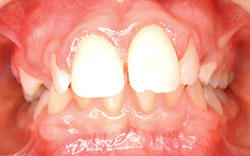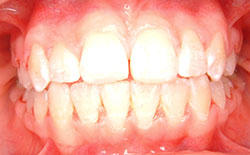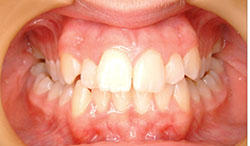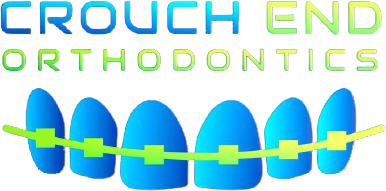Orthodontic Disorders
Orthodontic Disorders
(Malocclusions)
Protruded (stick out) upper front teeth - Increased Overjet
Protruded upper front teeth (upper front teeth extending too far forward) are prone to trauma and fracture*. This may indicate disproportionate upper and lower jaw growth (small lower jaw). Protruded upper front teeth are often associated with a smaller lower jaw. Thumb and finger sucking habits can cause a protrusion of the upper front teeth.
A common term that is used by the orthodontist is the overjet. Overjet is the horizontal overlap of the maxillary central incisors over the mandibular central incisors. It shows how much the upper front teeth protrude forward in relation to the lower front teeth. The normal overjet is about 2-3 mm. With excessive overjet, the upper front teeth often protrude ahead of the lower lip.
*An investigation into the association between facial profile and maxillary incisor trauma, a clinical non-radiographic study (Dent Traumatol. 2010 Oct;26(5):403-8.)
*The association between orthodontic treatment need and maxillary incisor trauma, a retrospective clinical study (Oral Surg Oral Med Oral Pathol Oral Radiol Endod. 2011 Dec;112(6):e75-80.)
Before & After
Increased Overjet-London
Increased Overjet-London

Before

After

Before

After
Crowded teeth
Crowding or having crooked teeth, is probably the most common reason to seek orthodontic treatment. Crowding occurs when teeth haven’t got enough space to erupt and have abnormal positions such as overlapping or displacement in various directions. This can be because there is not enough room for the teeth, the teeth are unusually large, or the jaw is small or narrower than it should be. Severe crowding may indicate removal of adult teeth to straighten the teeth.
Before & After
Crowded teeth London
Crowded teeth London

Before

After

Before

After
Crossbite
Crossbite exist where the upper teeth sit inside the lower teeth. A crossbite often makes it difficult to bite or chew properly. When closing the mouth, patients often move their lower jaw forward (anterior crossbite) or to the side (posterior crossbite), which can cause functional issues.
Before & After
Crossbite-London
Crossbite-London
Crossbite-London

Before

After

Before

After
Underbite
A crossbite of the front teeth, or the reverse bite, is commonly referred to as an underbite, if the lower front teeth sit in front of the upper front teeth.
Before & After
Underbite-London
Underbite-London
Underbite-London

Before

After

Before

After
Deep overbite or deepbite
Overbite is the amount of vertical overlap of the maxillary central incisors over the mandibular central incisors. The normal overbite is about 2-3 mm, or approximately 20-30% of the height of the mandibular incisors.

The deep overbite occurs when the upper front teeth (incisors) overlap too far over the lower teeth, almost hiding the length of lower incisors. In complete deepbite, the biting edges of the upper teeth may touch the lower front gum tissue and the lower front teeth may bite into the roof of the mouth. This can lead to tissue (gum) damage if left untreated.
Before & After
Deepbite-London
Deepbite-London
Deepbite-London

Before

After

Before

After
Class lll Malocclusions, Reverse Bite
Reverse bite or Class III bite can affect the way you chew and is more common in Asians; following are some adult cases successfully treated with removing 2 premolars in the lower jaw or without any extractions. Severe cases need surgical correction and nearly half of adult cases requiring jaw surgery are Class III malocclusion, for some of these cases we can use TADs or mini-implants to correct the case without surgery
Eslamian L, Borzabadi-Farahani A*, Badiee MR, Le BT (2019) An Objective Assessment of Orthognathic Surgery Patients. J Craniofac Surg. 2019 30(8):2479-2482.
Olkun HK, Borzabadi-Farahani A*, Uçkan S (2019) Orthognathic Surgery Treatment Need in a Turkish Adult Population: A Retrospective Study. Int. J. Environ. Res. Public Health 16, 1881.
Eslamipour F , Borzabadi-Farahani A*, Le BT, Shahmoradi M (2017) A retrospective analysis of dentofacial deformities and orthognathic surgeries. Annals of Maxillofacial Surgery 7(1); 73-77.
Borzabadi-Farahani A*, Eslamipour F, Shahmoradi M (2016) Functional needs of subjects with dentofacial deformities:Astudy using the index of orthognathic functional treatment needs (IOFTN). Journal of Plastic, Reconstructive & Aesthetic Surgery 69(6):796–801.
Harrington C, Gallagher JR, Borzabadi-Farahani A* (2015) A retrospective analysis of dentofacial deformities and orthognathic surgeries using the index of orthognathic functional treatment need (IOFTN). International Journal of Pediatric Otorhinolaryngology 79(7):1063-1066.









